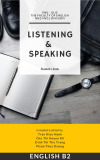
KHOA HỌC, GIÁO DỤC VÀ CÔNG NGHỆ
Volume 3, Issue 4 19
ENGLISH LISTENING COMPREHENSION OF SECOND YEAR
STUDENTS: DIFFICULTIES AND STRATEGIES
Nguyen Thi Van Anh1
Bui Hanh Trang2 Ha Cong Trong3
1, 2, 3Thanh Do University
Email: anhntv156@gmail.com1; reikacrystal@gmail.com2; Jantrongyt@gmail.com3
Received: 30/9/2024; Reviewed: 4/12/2024; Revised: 9/12/2024; Accepted: 16/12/2024
DOI: https://doi.org/10.58902/tcnckhpt.v3i4.175
Abstract: This study investigates the challenges second-year English language students face in
developing listening comprehension skill. Through a questionnaire survey, the research identifies key
obstacles such as limited vocabulary, unfamiliar accents, cultural differences, and the speed of speech,
all of which hinder effective listening. The study also examines the strategies students employ, including
note-taking, listening to audio materials repeatedly, and contextual guessing. The findings underscore
the need for targeted teaching methods to address these specific challenges and improve students'
listening proficiency. The research offers valuable insights for educators to design more effective
listening comprehension activities that can better support second-year learners in overcoming listening
barriers.
Keywords: Difficulties and strategies; English listening comprehension skills; Second-year
students.
1. Introduction
Listening is a fundamental language skill for
understanding the world around us and engaging
in successful communication. It involves a
complex process of identifying, understanding,
evaluating, remembering, and responding to
spoken language. However, English listening
comprehension can be a formidable challenge for
many learners, even those who have a strong grasp
of the language's grammar and vocabulary,
particularly at second-year university students.
This difficulty often stems from a variety of
factors, including accent variation, rapid speech,
colloquialisms, and cultural nuances making it a
significant obstacle in their language learning
journey. Navigating these obstacles requires a
combination of specialised listening skills and a
deep understanding of the English language. By
examining the factors that hinder listening
proficiency and exploring potential solutions, this
research aims to contribute to the development of
more effective listening instruction and support
strategies.
This study investigates the specific listening
problems experienced by second-year English
language students. Through data analysis and
insights from student perspectives, research aims
to identify practical strategies and
recommendations for improving listening
comprehension. By addressing these challenges,
this study seeks to empower English language
learners to become more effective listeners and
communicators, ultimately enhancing their
academic and professional success.
2. Research overview
Rost (2009) asserts that listening serves as a
fundamental tool for comprehending the external
world and constitutes an indispensable component
of effective communication. Thomlison (1984)
defines listening as the capacity to accurately
identify and interpret the messages conveyed by
others. This process necessitates a nuanced
understanding of the speaker's accent and
pronunciation, their grammatical structures and
vocabulary, as well as the underlying meaning. A
proficient listener demonstrates the ability to
execute these tasks concurrently.
As Howatt and Dakin (1974) posit, listening is
a cognitive process that requires the identification
and comprehension of spoken language. This
entails deciphering a speaker's accent and
pronunciation, as well as their grammatical
structures and lexical choices.
Ultimately, successful listening involves a

KHOA HỌC, GIÁO DỤC VÀ CÔNG NGHỆ
20 JOURNAL OF SCIENTIFIC RESEARCH AND DEVELOPMENT
dynamic process of interpretation, whereby
listeners correlate auditory input with their
existing knowledge to derive meaning from the
spoken word.
Listening is an indispensable component of
language acquisition, as it provides the essential
aural input for language development and
facilitates meaningful participation in spoken
discourse. Communication necessitates effective
listening skills, with a significant portion of
communication time dedicated to listening,
accounting for approximately 40-50% of the total
time, while speaking occupies 25-30%, reading
11-16%, and writing 9% (Mendelsohn, 1994).
This data underscores the pivotal role of listening
in communication, as it consumes half of the
communication time and is a fundamental
prerequisite for effective communication.
Listening serves as a primary conduit for acquiring
education, information, understanding of the
world and human affairs, ideas, values, and
appreciation. In the contemporary era of mass
communication, predominantly oral in nature, it is
imperative that students are equipped with the
ability to listen effectively and critically.
The process of effective listening can be
divided into five sequential stages: reception,
comprehension, evaluation, retention, and
response. Each of these stages will be examined in
greater depth in subsequent sections. A proficient
listener must initially perceive and identify the
auditory stimuli directed towards them, then
interpret the meaning conveyed within those
sounds. Following this, the listener must critically
assess and evaluate the message, ensuring its
accuracy and relevance. Additionally, the listener
must retain or remember the information
presented, and finally, respond appropriately to
the message, whether through verbal or nonverbal
means.
Receiving (Hearing)
Hearing, a fundamental physiological process,
involves the transduction of sound waves into
neural signals by the eardrum. While it may appear
self-evident, effective listening necessitates the
ability to perceive auditory stimuli. The clarity of
sound directly influences the ease with which
listening can be accomplished.
Understanding
The ability to comprehend spoken language is
essential for daily interactions, especially
information acquisition. In various settings, such
as workplaces and educational institutions,
individuals rely on listening to superiors and
teachers for guidance and knowledge. Even
political discourse involves listening to
candidates' speeches to make informed decisions.
However, effective listening requires a deep
understanding of the spoken message. One
strategy to enhance comprehension is through
active questioning. By posing inquiries, listeners
can clarify ambiguities and construct a more
accurate mental representation of the speaker's
intended meaning.
Evaluating
During the evaluation phase of
communication, the listener critically assesses the
speaker's message. They determine the message's
coherence, objectivity, veracity, and relevance.
Additionally, listeners analyze the speaker's
motivations and the methods used to convey the
message. This involves considering factors such
as the speaker's personal or professional goals. For
instance, a listener might recognize the factual
accuracy of a coworker's criticism but also
understand that personal stress, such as a sick
child, could be influencing their emotional
response. Similarly, a voter can evaluate the
persuasiveness of a political candidate's speech
and decide whether their arguments warrant
support.
Remembering
During the cognitive stage of listening, the
audience actively categorizes and stores incoming
information for subsequent retrieval. Effective
recall of prior knowledge is essential for
comprehending new material and placing it within
a broader context. Conversely, passive or
inattentive listening can significantly impair
retention, as minimal cognitive effort is needed to
process the speaker's content.
Responding
Active engagement in the listening process is
crucial for effective communication. Speakers
often rely on both verbal and nonverbal cues from
listeners to gauge the comprehension an d

KHOA HỌC, GIÁO DỤC VÀ CÔNG NGHỆ
Volume 3, Issue 4 21
consideration of their message. This feedback
allows speakers to adapt their communication
style accordingly.
Language modalities can be broadly
categorized into spoken and written forms. While
listening and speaking are integral components of
spoken language, reading and writing are
associated with written language. Despite the
widespread desire for English fluency, many
learners overlook the importance of developing a
comprehensive set of English language skills.
Consequently, language instruction often
prioritizes spoken language, particularly
conversational skills, at the expense of other
language modalities, such as listening
comprehension. This imbalance may contribute to
the challenges individuals encounter when
listening to English (Rintaningrum, 2018a).
Second-year students at Thanh Do University
face significant challenges in online listening
comprehension, a receptive language skill.
However, from an information processing
standpoint, listening is an active cognitive process
in which learners selectively attend to and
interpret auditory and visual cues to decipher the
speaker's intended message (Thompson & Rubin,
1996). Underwood (1989) identifies several key
challenges in listening comprehension, including:
difficulty controlling speaking speed, inability to
request repetition, limited vocabulary, failure to
recognize linguistic cues, interpretive issues, lack
of concentration, and established learning habits.
Learners often encounter significant obstacles
in comprehending spoken English. Several key
factors contribute to these difficulties are as
follows:
Audio Quality
The quality of recorded materials used in
instruction can significantly impact
comprehension. Poor audio quality can hinder
students' ability to discern sounds and understand
spoken content.
Cultural Context
Cultural differences play a crucial role in
language comprehension. If listening materials
contain unfamiliar cultural elements, learners may
struggle to understand the intended meaning. It is
essential for teachers to provide students with
relevant cultural background information to
facilitate comprehension.
Accent Variation
Christine Goh (1999) noted that speaker
accents can be a major obstacle to listening
comprehension. Unfamiliar accents, both native
and non-native, can pose challenges for learners.
Familiarity with an accent, however, can enhance
comprehension.
Vocabulary Familiarity
Learners are more likely to comprehend
familiar vocabulary in listening texts.
Understanding word meanings can increase
interest, motivation, and overall listening
comprehension. However, it is important to note
that many words have multiple meanings, and
learners may become confused if these meanings
are not used appropriately in context.
3. Research methods
The questionnaire incorporated both closed-
ended and open-ended questions. This mixed
approach was adopted to balance the advantages
of each format. Closed-ended questions facilitated
efficient data collation and analysis, while open-
ended questions offered greater flexibility,
allowing respondents to provide more detailed and
nuanced answers.
The study involved 26 sophomore English
majors at foreign language and tourism
department of TDU. As second-year English
major students, they were likely encountering
common academic challenges.
A structured questionnaire was developed to
assess the students’ listening comprehension
challenges and the strategies they employ. The
questionnaire was distributed to the students in an
online format and took approximately 5-10
minutes to complete. The questionnaire responses
was analyzed using descriptive statistics (such as
frequencies and percentages) to identify the most
common difficulties students face and the most
frequently used strategies.
There are two research questions:
- What are difficulties in listening
comprehension?
- What should be done to overcome the
difficulties?
4. Research results
The analysis of student responses regarding the
challenges they encountered in learning English

KHOA HỌC, GIÁO DỤC VÀ CÔNG NGHỆ
22 JOURNAL OF SCIENTIFIC RESEARCH AND DEVELOPMENT
was conducted to address the research questions.
According to the survey, a significant majority,
67% of the students, believe that listening skills
are difficult to acquire. Meanwhile, 33% of
students feel that listening skills are not
challenging. This suggests that the majority of
students face challenges in mastering listening
comprehension, indicating a potential area of
focus for educational improvement or support.
The high percentage of students struggling
highlights the need for strategies to enhance
listening instruction and practice.
Regarding the question of whether participants
had failed the listening exam in the past, it is
evident that half of these students had multiple
instances of failure. Following that, nearly 45% of
participants reported that they had never failed the
exam. Additionally, more than 5% of learners
indicated that they had failed the exam only once.
In terms of represents students' responses to
whether their instructor provided specific study
methods, a vast majority of 94% of students
indicated that the instructor did offer study
methods, while only 6% responded negatively.
The preponderance of positive responses indicates
that a majority of instructors are actively engaged
in facilitating their students' academic progress
through the implementation of organized learning
strategies. The small percentage of students who
did not receive specific methods could indicate
either a lack of clarity in instruction or individual
perceptions of the study guidance given. Overall,
the analysis reveals a positive association between
instructor involvement and student academic
success.
In response to the next question regarding
whether students regularly practiced their
listening skills at home, half of the participants
indicated that they did so frequently. This number
nearly doubled the percentage of those who
usually do this at home with approximately 28%.
Following that, only 16,7% of students responded
seldomly. In contrast, the proportion of people
practicing the skill daily was just 5,6%.
The diagram above outlines various methods
students use to practice their listening skills at
home. The most popular method, chosen by 70%
of respondents, is listening to English music. This
is followed by watching English films, with 55%
of students using this method. Listening to
podcasts or audio by native speakers is another
common practice, with 22% of students choosing
this option, while 17% listen to English news. Less
common strategies include listening to college
textbook tapes (11%), watching YouTube (6%),
and copying dictations (6%). These results suggest
that students prefer more engaging and
entertaining mediums like music and films for
practicing listening, while more traditional
methods like dictation and textbook audio are less
favored.
For how much time students spend each day
practicing listening skills, it can be seen that 1
hour is the most popular duration, with 55,6% of
learners in the survey. The number of individuals
who spent more than 1 hour per day on this
activity was twice that of those who spent less than
1 hour, reaching approximately 27%.

KHOA HỌC, GIÁO DỤC VÀ CÔNG NGHỆ
Volume 3, Issue 4 23
Subsequently, nearly 17% of participants
allocated 2 hours to this endeavor.
Regarding how to tackle the issue of facing
new phrasal verbs of vocabulary that students do
not understand, the majority of people choose to
predict the meaning, with more than 65%. This is
followed by learners ignoring and going on with
their listening, at more than 27%. As for the least
common solution, only 5.6% of students decide to
pay no attention to new words during the tasks.
As for the challenges that students may
encounter when practicing listening skills, the two
most common problems are limited vocabulary
and not understanding what the listener is saying,
both taking up 77,8%. At the same time, the
figures for problems such as the lack of
concentration or social knowledge or poor quality
of audio speakers were at nearly 40%. On the
contrary, there were no respondents who did not
understand the question or the content of the
listening text.
5. Discussion
The study revealed that second-year students
face several significant barriers to effective
listening comprehension. Students who lack
sufficient vocabulary often struggle to make sense
of spoken language, particularly when listening to
authentic materials. Furthermore, unfamiliar
accents also emerged as a significant challenge for
many students. As English is spoken with various
accents worldwide, it is essential for students to
develop an ability to understand different
pronunciations, intonations, and speech patterns.
Another notable challenge identified in the study
was speech speed. In real-life situations, native
speakers often talk quickly, and this poses a
considerable challenge for learners, especially
when they are not accustomed to the natural
rhythm and pace of spoken English. Despite these
challenges, students in the study employed a
variety of strategies to improve their listening
comprehension.
Research has consistently demonstrated the
efficacy of various listening strategies in
enhancing language learning outcomes.
Vandergrift (1999) posited that metacognitive
strategies, when coupled with cognitive
approaches, significantly contribute to listening
achievement. Less proficient learners frequently
employed cognitive and memory strategies while
underutilizing social strategies. Conversely, more
proficient learners demonstrated a more strategic
approach, often utilizing top-down and
metacognitive strategies that align with effective
listening skills. In contrast, less proficient learners
tended to rely on bottom-up strategies, eschewing
top-down approaches.
The questionnaire responses indicate that a
significant majority of students favor
incorporating English songs into their listening
classes. This preference stems from the perceived
benefits of familiarizing oneself with song lyrics,
which can enhance vocabulary acquisition and
foster a more engaging learning environment.












![Đề cương môn Tiếng Anh 1 [Chuẩn Nhất/Mới Nhất]](https://cdn.tailieu.vn/images/document/thumbnail/2025/20251130/cubabep141@gmail.com/135x160/51711764555685.jpg)










![Mẫu thư Tiếng Anh: Tài liệu [Mô tả chi tiết hơn về loại tài liệu hoặc mục đích sử dụng]](https://cdn.tailieu.vn/images/document/thumbnail/2025/20250814/vinhsannguyenphuc@gmail.com/135x160/71321755225259.jpg)


